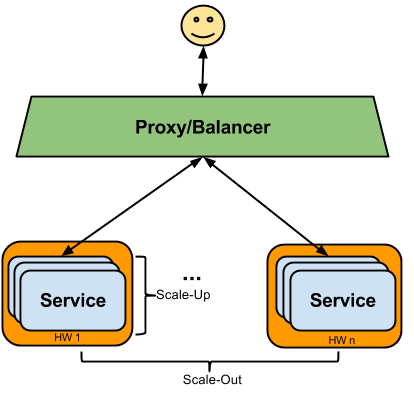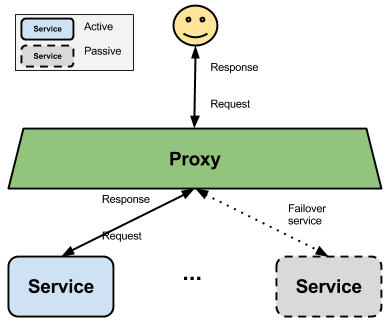Introduction To Clustering and High Availability¶
Clustering techniques are used to improve performance and availability of a complex system. Generally speaking a cluster is intended as a redundant set of services providing the same set of functionalities.
Cluster quality can be measured by:
- Reliability the ability to successfully provide responses on each incoming request
- Availability the uptime of the server (usually measured as % of annual uptime)
- Performance measured by the average of the time spent by the service to provide responses or by the throughput
- Scalability is the ability to handle a growing amount of work in a capable manner without degradation in the quality of service (e.g. non-decreasing throughput)
High-availability¶
High-availability (HA) clusters are groups of services that can be reliably utilized with a minimum (or null) down-time. Without clustering, if a service crashes or is too busy, the user asking for that service will never get a quick response. HA clustering should be designed to remedies this situation by detecting service down (using a watchdog), and immediately restarting it. During this operation the service will be provided by a failover instance of the same service.
Scalability¶
- Scaling a software usually means adding more instances of the product. We can distinguish two different ways of scaling:
- Horizontal Scalability also known as scale out which can be performed by adding additional HW resources to the existing pool. In our context this means adding more physical or virtual machines with GeoServer installed.
- Vertical Scalability also known as scale up which can be performed by getting more powerful hardware (single box with more CPUs/memory), and that normally needs to be compounded by adding more SW instances as well on the same boxes (as in practice no software is 100% linearly scalable) In our context this means installing more GeoServer instances on the existing HW to fully utilize available resources, in particular the extra CPUs.
Note
Notice that in our context saying a GeoServer instance means a separate Java process running GeoServer (e.g. a Tomcat running instance). It is to be noticed that the main scalability bottleneck, the Java own rasterizer, is an issue in Oracle JDK, and can be reduced/eliminated by either installing OpenJDK instead of Oracle JDK, or by installing the Marlin renderer in a Oracle JDK.
Here below you can find an illustration showing both scalability mode at the same time.

Illustration: Horizontal VS Vertical Scalability
Cluster Configurations¶
A cluster can be configured as:
- Active/active All the node of the cluster are active at the same time. The traffic is distributed on all the services.

Illustration: Active/Active cluster configuration
This gives maximum performance but if a single HW instance fails the overall throughput and response time may suffer. On the other side this set-up provide maximum performance.
- Active/passive Provides a fully redundant instance of each node, which is only brought on-line when its associated primary node fails.

Illustration: Active/Passive cluster configuration
This gives maximum availability but does not fully utilize all the resources available since at most times part of them will be not utilized.
